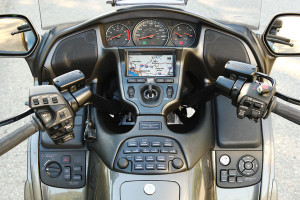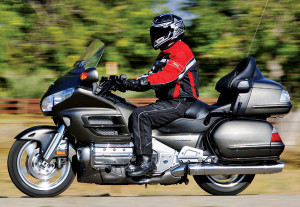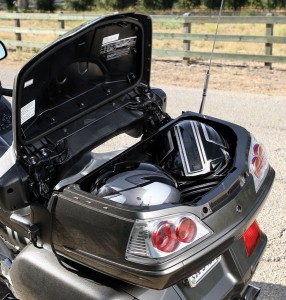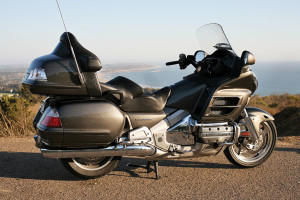2010 Honda Goldwing Review
photography by Rich Cox
[This 2010 Honda Gold Wing GL1800 Road Test was originally published as a Ridden & Rated in the June 2011 issue of Rider magazine]

Spend a little time on Gold Wing online forums and you'll see references to "Mother Honda." Over nearly four decades, Mother Honda has begotten quite a brood. More than 640,000 Gold Wings have been built since the GL line was introduced in 1974, and their owners are like a big family, with all of the fierce loyalty, divided opinions and struggles that implies.
When Honda pulled the covers off its 2012 Gold Wing GL1800 ABS, members of the family didn't pull any punches. The GL1800—the fifth stage in the GL's evolution—has changed little since its 2001 debut, and with Gold Wing production moved from Ohio to Japan and no 2011 models produced, expectations ran high. As we chronicled last month, the 2012 Gold Wing will get many useful enhancements but not the complete overhaul many were hoping for. Rather, it will be a capstone model, the GL1800's last hurrah before the next era begins. The incremental changes are unlikely to sway many GL1800 owners to trade up. Instead they'll sit tight until the next Gold Wing arrives, probably within a couple of years (the Gold Wing turns 40 in 2014).
Advertisement
 At Rider, we're at a crossroads. Also reported in our previous issue, I rode the new BMW K 1600 GTL—the Gold Wing's strongest competition yet—at its world press launch in South Africa. But we won't get a chance to compare the 2012 Gold Wing with the GTL for another couple of months. Meanwhile, we've been racking up miles of smiles on a 2010 Gold Wing for the better part of six months. Relegating it to has-been status would be premature; devoted GL1800 enthusiasts see the 2010 model as the last "pure" American-made Gold Wing. Whereas styling of the 2001-2010 GL1800 flows organically with consistent coloring, the 2012 GL1800, with its squared-off saddlebags and two-tone paint, is less cohesive and has been called derivative of the BMW K 1600 GTL and Victory Vision. That the lines of the 2012 Gold Wing's saddlebags no longer match the trunk is particularly irksome.
At Rider, we're at a crossroads. Also reported in our previous issue, I rode the new BMW K 1600 GTL—the Gold Wing's strongest competition yet—at its world press launch in South Africa. But we won't get a chance to compare the 2012 Gold Wing with the GTL for another couple of months. Meanwhile, we've been racking up miles of smiles on a 2010 Gold Wing for the better part of six months. Relegating it to has-been status would be premature; devoted GL1800 enthusiasts see the 2010 model as the last "pure" American-made Gold Wing. Whereas styling of the 2001-2010 GL1800 flows organically with consistent coloring, the 2012 GL1800, with its squared-off saddlebags and two-tone paint, is less cohesive and has been called derivative of the BMW K 1600 GTL and Victory Vision. That the lines of the 2012 Gold Wing's saddlebags no longer match the trunk is particularly irksome.
All GL1800s, from 2001 to 2012, share the same strengths and weaknesses. Large Project Leader for the GL1800 was Masanori Aoki, a sportbike enthusiast and engineer who worked on Honda's CBR line. Telling is this 2001 quote from Aoki: "We set out to keep 80 percent of the Gold Wing's touring capability" while introducing much sportier power and handling. With gobs of power (101 horsepower and 106 lb-ft of torque; Rider, April 2009), a sportbike-like twin-spar chassis and a low, well-balanced center of gravity, when it debuted the GL1800 blasted through limitations normally placed on 900-pound touring bikes. Moto-journalists and performance-oriented touring riders swooned; others were sorely disappointed about losing 20 percent of the GL1500's touring capability. The more sculpted GL1800 lost luggage capacity relative to its predecessor, an unforgivable transgression for hardcore two-uppers. The 2012 Gold Wing gains 7 liters of capacity, but that's only 4-5 percent more than the 147 liters on the 2010 model. Total capacity is important, but the GL1800 also suffers from oddly shaped saddlebag and trunk openings and cavities. By way of comparison, the saddlebags on the BMW K 1600 GTL hold 33 liters each vs. 40 liters on the Gold Wing, but each GTL saddlebag easily accommodates a full-face helmet while a comparable helmet barely fits in the 2010 Gold Wing's left saddlebag only.

As important as luggage capacity is, thousands of GL1800 owners have learned to live with it. Some have bolted on trunk racks, others tow trailers or added huge trunks as part of trike conversions. Or they just pack less. You'll find no complaints about the GL1800's butter-smooth engine, spry handling, stout brakes or creature comforts. Nearly four decades of kaizen (continuous improvement) have resulted in an incredibly refined motorcycle—the textbook definition of luxury touring. And Gold Wings are stone reliable, with many owners racking up hundreds of thousands of miles.
But the GL1800 isn't perfect. No one bike can completely satisfy everyone on all counts—ergonomics, features, fuel economy, price, etc. To find out about the most common issues, I called up Mike Douglas, co-owner of JBJ Cycles in Santa Ana, California (www.jbjcycles.com), Gold Wing specialists who recently serviced our GL1500 staff bike and photo wagon. He said some GL1800 owners complain of a wobble around 40 mph, which is often fixed by swapping the stock ball bearings in the steering head with tapered roller bearings. Others complain of harsh damping in the front fork, which has an unusual design. The right fork leg has a cartridge and the left fork leg has a damper rod with an anti-dive system that uses brake-fluid pressure. Upgrades from companies like Traxxion Dynamics, Progressive Suspension and Race Tech replace some or all of the fork internals and allow riders to dial in the suspension to their weight and riding style.

An issue that has received lots of attention on forums concerns the GL1800's transmission. Some owners have problems with transmissions popping out of fifth (top) or second gear. JBJ Cycles services more than 40 Gold Wings every month, but it hasn't had to rebuild many GL1800 transmissions. But, in some cases, the middle shift fork, which has a long throw, will get too hot and bend out of shape. The problem can be exacerbated by an aftermarket heel-toe shifter. In thousands of miles on GL1800s, we've never experienced transmission problems. JBJ sees very few major problems on Gold Wings; if maintained according to the recommended schedule they'll run forever (Mike has more than 300,000 miles on his personal GL1500).
We now know what will and won't be changed on the 2012 Gold Wing, which will extend the GL1800's illustrious legacy a while longer. For the next-generation GL, we've got a few ideas….
Dear Mother Honda,
Thank you for bestowing the GL1800 with such a wonderful engine. We hope the GLxxxx engine will be just as smooth, but we'd love more power and better fuel economy. And how about a new transmission, preferably one with six gears and a semi-automatic Dual-Clutch Transmission option? No use putting in new carpet without changing the drapes, so upgrading the suspension and offering push-button adjustability front and rear would be grand. We're way overdue for standard ABS, adjustable ergonomics, an electrically adjustable windscreen and a programmable tire-pressure monitor that shows front/rear pressure values. Shedding some excess weight would make the Gold Wing look and feel better. And, above all, please give us more load and luggage capacity.
Sincerely yours,
Us
 2010 Honda Gold Wing GL1800 Specifications
2010 Honda Gold Wing GL1800 Specifications
Base Price: $22,899
Advertisement
Price as Tested: $26,599 (Audio Comfort Navi XM ABS model)
Website: powersports.honda.com
Engine Type: Liquid-cooled, longitudinal opposed flat six, SOHC, 2 valves per cyl.
Bore x Stroke: 74.0 x 71.0mm
Displacement: 1,832cc
Transmission: 5-speed, hydraulically actuated wet clutch, with electric reverse
Final Drive: Shaft, 2.75:1
Wheelbase: 66.5 in.
Rake/Trail: 29.1 degrees/4.3 in.
Seat Height: 29.1 in.
Wet Weight: 898 lbs. (as tested)
Fuel Capacity: 6.6 gals., warning light on last 1.0 gal.
MPG: 86 PON min. (high/avg/low) 36.4/33.8/22.2
Source: https://ridermagazine.com/2011/06/21/2010-honda-gold-wing-gl1800-road-test-review/

0 Komentar